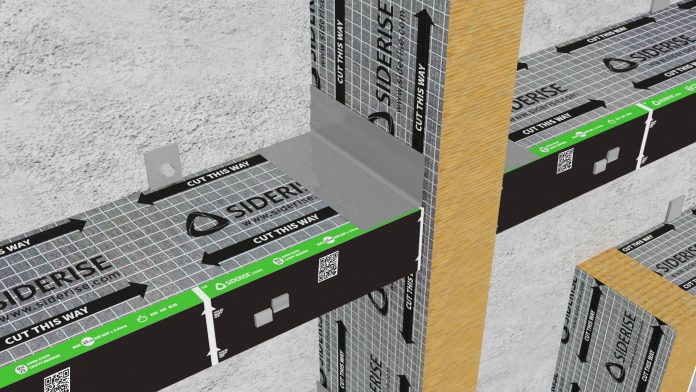In this article, Siderise Insulation explains how digital tools can help to ensure long-term passive fire protection for buildings
Passive fire protection is fundamental to ensuring that the risk of a fire spreading and compromising the safety of occupiers is minimised for the lifetime of the construction.
However, as part of the building envelope, they are often hidden by the façade by the time of the Building Control inspection. Therefore, it is vital that measures are put in place to ensure accuracy at both the specification and installation stages. To support this – and meet the wider calls for a more transparent and quality-focused construction industry – several useful digital tools have been created.
Why is passive fire protection so important?
Passive fire protection is a legal requirement for both domestic and non-domestic properties under Approved Document B of the Building Regulations (Fire Safety).
It is incorporated into the building structure and works by limiting the spread of flames, heat and smoke to create areas of manageable risk with fire-resistant materials and gap-filling measures. This is known as compartmentation and serves to keep the fire in one location, protecting escape routes, making it easier for the fire service to gain control and preventing further damage. Solutions include everything from fire doors to cavity barrier and firestops installed within the wall cavities which, if left unprotected, can act as a chimney for fire to spread into other building compartments.
Why are inspections of passive fire protection installations vital and how can digital inspection tools help?
As their name suggests, passive fire protection products are designed to work without any input from the building managers or users. To do this effectively, they must be installed correctly within the building structure. However, as passive fire protection systems are concealed within the building’s construction, it can be difficult for building safety assessors to pick up on faulty installations.
Therefore, it is firstly important installation is undertaken by competent and skilled contractors who can demonstrate their commitment to accurate workmanship. Manufacturers can often offer comprehensive technical and site services and training – as well as options to audit the installation of their products during the construction phase.
Inspections are a regular requirement for many projects. However, with tight deadlines to meet, project teams often rely on the Building Control inspection which, as mentioned, typically takes place when the passive fire protection products have been covered by the facade. While some projects may need or prefer an in-person inspection, manufacturer-developed inspection apps can allow for this assurance without the added time of arranging a visit from their site services.
Typically only suitable for standard systems, they can allow users to capture images as each area/element is installed and update the data input fields using their smartphone or tablet. The app then immediately turns this into a comprehensive report, which can be reviewed offsite by a technical team to ensure the installation meets recommendations and quickly identify if any areas need remedial actions.
In addition, the report generated by the app provides a valuable visual record of hidden elements of a construction once the build is complete. This means it is clear exactly what’s in the building and how it was installed. This can be passed over to the building owner at sign off and used to inform any future maintenance or building work.
How can digital tools be used to preserve the ‘golden thread’ of product information beyond the initial installation?
In addition to preserving information on how a product is installed, there are also new digital tools that allow the data and information about a specific product to be easily accessed years after its installation.

Digital identification platforms, such as BSI Identify, provide a straightforward solution to product traceability. Dedicated QR codes are added to products linked to BSI UPINs (unique persistent identification numbers), which are applied to every construction product within the BSI Identify database.
When scanned, this will take the user to the exact product data supplied by the manufacturer, attributable to the day it was manufactured, whether that was yesterday or a decade later. This ensures that anyone can easily find all the correct product information relating to specification, testing, installation and maintenance – including historic performance credentials, safety data and more.
This will be particularly useful for renovation works, and has “real time” value too, allowing contractors and inspectors to access to information that will assist in on site application and checks, such as installation videos or standard details – further helping to ensure a quality installation.
Safety in data
Understanding what has been installed on a building and how is absolutely vital to maintaining fire safety. Digital tools are a simple and accessible way to both verify the quality of installations and keep a log of the product data beyond the construction phase, helping to ensure that the passive fire safety measures will perform as expected.
For more information, please visit www.siderise.com
Helen Massay
Marketing Manager
Siderise Insulation Ltd
Tel: +44 (0) 1656 730833


















Quite an informative article! Passive fire protection is an essential component of any building structure. It inhibits or obstructs the propagation of fire effects without requiring system activation. Passive fire protection divides the structure into compartments and uses fire-resistant walls to inhibit the spread of fire.